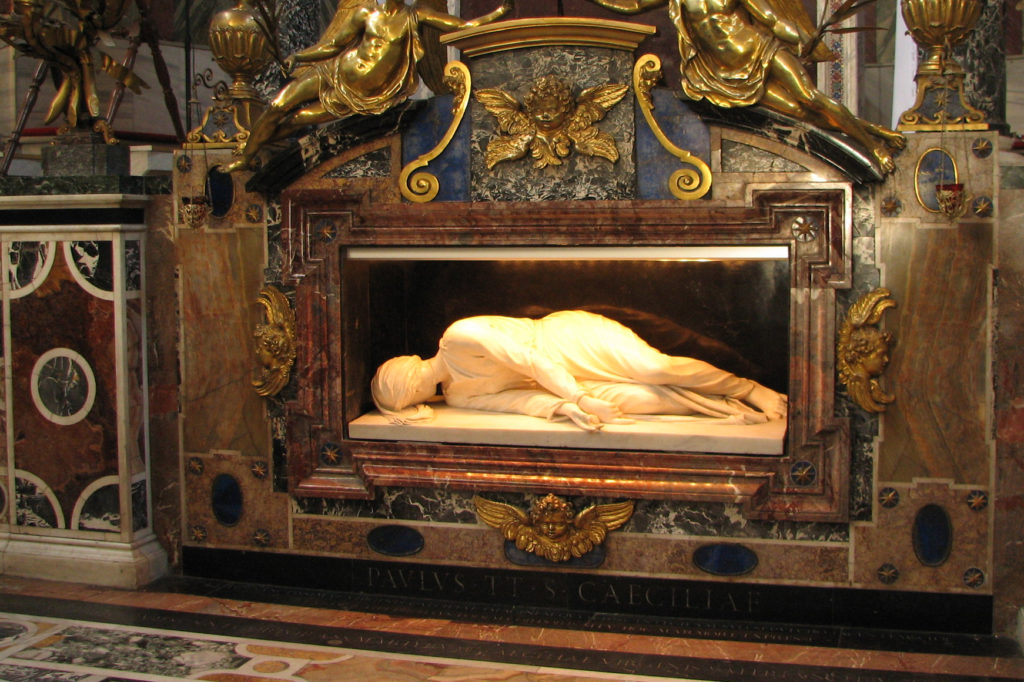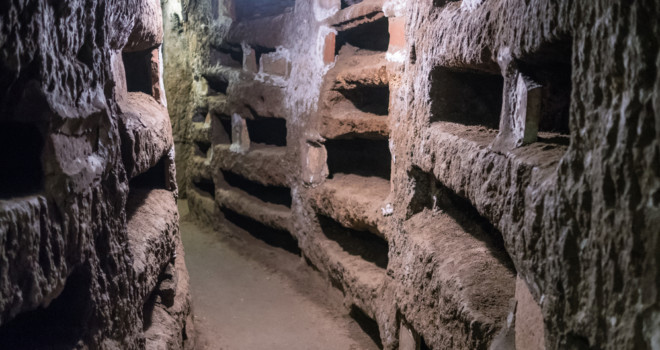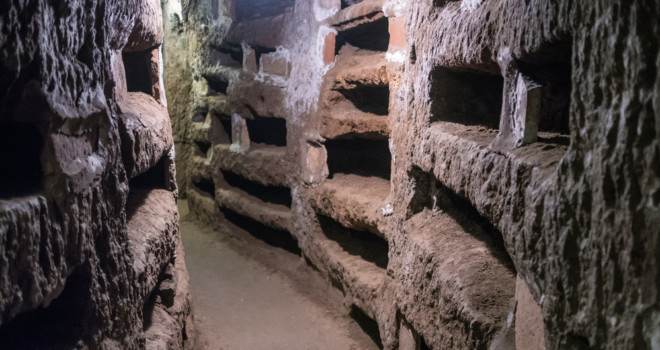When I accompanied my husband on a work trip to Italy, his task was to visit archeological sites related to the early Church. Of course, that included the catacombs.

There are several catacombs in Rome, but among the most famous are the Catacombs of San Callisto (also called the Catacomb of Callixtus). Approximately half a million early Christians were buried in these catacombs, layered in four different underground levels (most of which are closed to the public). The catacombs are so extensive that they can only be viewed with a guide.
Although early Christians gathered to pray in the catacombs, their primary purpose was for burial. These burials were necessary because visiting the remains of your loved ones was a risky business, and many saints were martyred (and later buried) at the catacombs.
Many famous saints were buried in the catacombs at first. Most of these popular saints can be found in churches. However, there were even more unknown saints buried in the catacombs. These were ordinary men and women who sacrificed everything to follow Christ.
Visiting the Catacombs as a Catholic
Although many visit the catacombs out of curiosity, the catacombs can also be a place of pilgrimage (even on an ordinary tour). As I walked through the winding, dark tunnels of the catacombs, I was cognizant of the fact that I was walking in the footsteps of my brothers and sisters in Christ. The men and women who were buried here were ordinary Christians, just like us.
This was especially made real for me when our guide pointed
to a tiny slot in the wall. She explained that it was where a child had been
buried. As she explained the ways that the Christians marked the tombs (with
shells and lamps) so that they could re-visit the burial places of their loved
one, I thought of the mother who must have come to visit this tomb. I thought
of how much she must have ached with longing for that child. On my chest, in a
baby carrier, I was carrying my youngest daughter (who was napping), and I held
her closer at the thought. I have my own little gravesite that I visit, the
grave of my third child, Gabriel. Gabriel is buried in a Catholic cemetery, and
his remains were commended to the earth by our pastor, using the prayers of the
Church. Whenever I visit him, I ache for him and long for the final
resurrection. So, too, did this poor mother. When she visited the catacombs,
she clung to the same hope that I cling to.
I realized that the men and women who visited these
catacombs were not much different than you or me – with one important
exception. They knew that going to the catacombs to bury their loved ones or
tend to their graves could result in their own martyrdom. They did it anyway.
That kind of reverence for the human body, that kind of deep desire to entrust
the remains of a loved one to consecrated ground, could only come from an
ardent faith in the resurrection of the body. These men and women believed what
Christ had taught them. They lived in hope of the final resurrection.
St. Cecilia’s Faith
St. Cecelia, patron saint of musicians, was originally buried
in the catacombs (following her martyrdom). There is a statue of her in the
place where she was once buried and on the walls are ancient frescoes depicting
this saint.
But St. Cecilia is now buried in the Basilica of Santa Cecilia in Trastevere in Rome. Her remains are in a chapel under the church (they are located directly below where the altar is). On the level of the church, there is a striking statue of Cecilia under the altar (this statue is the one that the statue in the catacombs is modeled after).

When you visit the chapel where Cecilia is buried, an inscription tells you that she is not buried alone. In the tomb with her is her husband. He was not a Christian at the time of their marriage, but her incredible faith in Christ converted him, too. He honored her vow of virginity and supported her in her faith. In fact, her husband was one of the men who risked his own life to bury Christians in the catacombs. He was eventually martyred, too.
The afternoon that we visited that church, we were walking
around with a priest friend of ours. He agreed to hear my confession, and we knelt
in a side chapel in the church of St. Cecilia for confession.
Afterwards, I knelt at the altar rail to say my penance and
gaze at the statue of St. Cecilia. Suddenly, I was struck with a deep, deep sense
of peace. For just a moment, I could see with clarity that the faith of St. Cecilia
was real. After visiting the catacombs and now visiting Cecilia, I realized
that our Catholic faith is worth living for. It is worth suffering for. It is
even worth dying for.
I am often afraid. I have anxiety, which makes me worry about
many, many things. I am afraid to face my fears. I am afraid of the future.
But as I gazed at Cecilia’s tomb and recalled the catacombs,
I knew that God really was in
control. For just a moment, I glimpsed with clarity that our faith is true and
that if we cling to it, then nothing can conquer us – not even death itself.
Do not be afraid. Christ has conquered the world.













